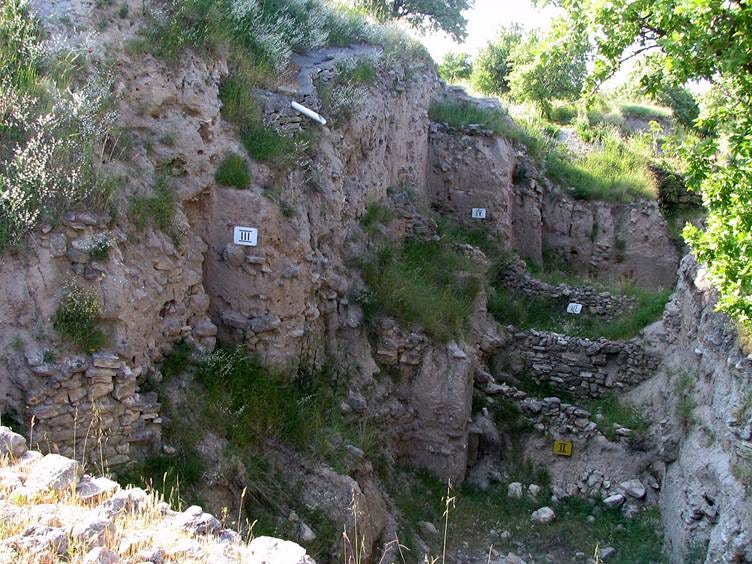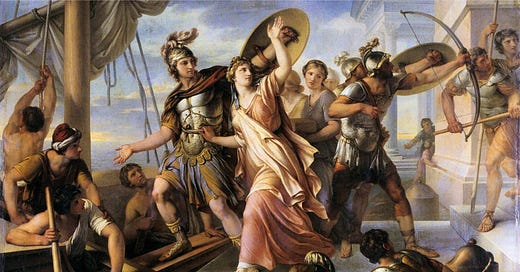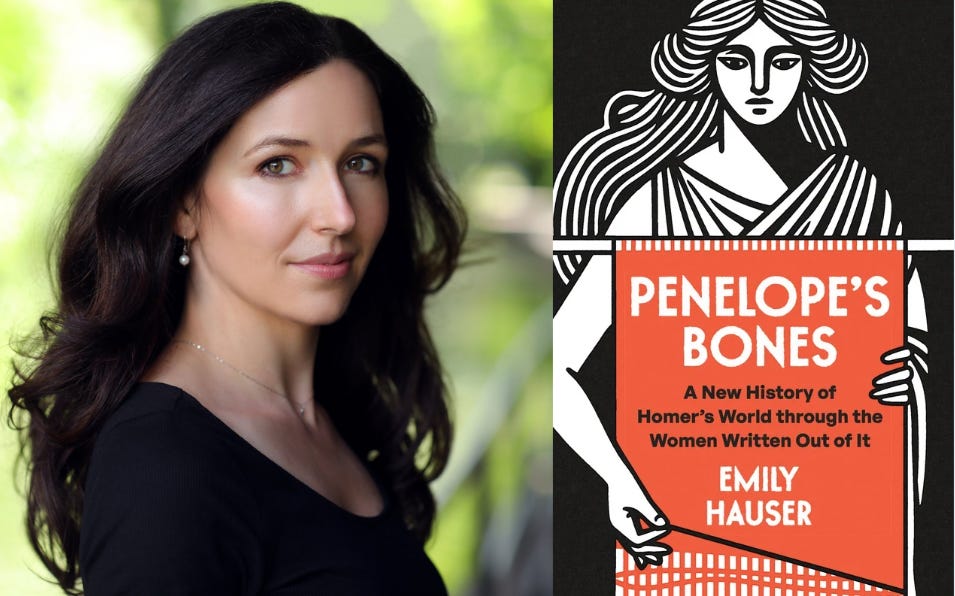In Search of the Real Helen of Troy
Guest post by classicist Emily Hauser, plus a chance to win her new book, PENELOPE'S BONES
I’m pleased to welcome special guest Emily Hauser for a post this week. I first met Emily years ago, when we bonded over our first novels, hers about ancient Greek gods (For The Most Beautiful) and mine about ancient Roman patricians (Feast of Sorrow). Since then, she's become an award-winning ancient historian and Times bestselling author who studied Classics at Cambridge under the renowned Mary Beard (one of my heroines!), where she earned a double first with distinction and the prestigious Chancellor's Medal. Her research focuses on reimagining classical narratives through a feminist lens, challenging traditional interpretations of ancient texts and recovering the agency of women who have been marginalized in historical accounts. Her new book, Penelope’s Bones: A New History of Homer’s World, through the Women Written Out Of It, explores the real women behind the myths through groundbreaking archaeological evidence, and I absolutely can't wait to read it. Today, Emily applies this same rigorous approach to one of history's most famous and misunderstood women: Helen of Troy. Who was she really, beyond the face that launched a thousand ships?
In Search of the Real Helen of Troy by Emily Hauser
The search for Helen of Troy is as old as history itself. We might think of Helen as the prototypical myth, a legend of fabulous beauty (she was said to be the most beautiful woman in the world) and devastating epic wars (the ten-year Trojan War was fought, according to Homer’s epic the Iliad, because of her). After all, her father was rumoured to be Zeus, king of the gods, and the story went that she hatched from an egg after he raped her mother, Leda, in the form of a swan. It doesn’t sound much like history.

But the ancient Greeks weren’t so sure. When the ancient Greek historian Herodotus, the so-called ‘Father of History’, writes his Histories around 420 BCE – the first known history in the West – he heads off in search of stories about Helen, trying to work out whether she did, in fact, go to Troy. He travels around the Mediterranean, including Egypt, trying to piece together her story; and when he tells his narrative of the wars (between Greeks and Persians in the east) that are happening in his own time, he traces it back to the original seizure, by Paris, prince of Troy, of a very real Helen. This is a Helen who is not just a part of Greek history: she’s a piece in the puzzle of explaining why it’s happening at all.
The obsession with discovering the real Helen – and slotting her into history – doesn’t abate as time goes by. If anything, it increases. In the late nineteenth century – so, a good two millennia after Herodotus was writing – a German banker and Homer obsessive, called Heinrich Schliemann, decided that he was going to be the one to discover the ‘real’ city of Troy, and with it, evidence for a ‘real’ Helen. Acting on a tip-off from a British consular official in western Turkey, Frank Calvert, he fixed on a particular mound in the north-western region of Turkey around modern Çanakkale, known as Hisarlık. Determined to get to the evidence straight away and not one to take advice, Schliemann used dynamite to blast through much of the site, going deep into the mound. Discoveries abounded – including not only a lost ancient city, but an astonishing treasure trove of jewels that Schliemann immediately declared ‘the jewels of Helen’. He even draped them on his wife, Sophia, and published the image in the world’s media to trumpet his new find of the lost city of Troy and Helen’s golden crown.

But was this really Troy – and had he really found Helen? On some counts, yes – and on others, a resounding no. While most archaeologists now agree that the site Schliemann and Calvert excavated is likely to have been that associated in antiquity with ancient Troy, Schliemann’s haste to get to the bottom of it (quite literally) and his lack of archaeological training meant that he actually blasted through most of the layer of the site that we’d now associate with ‘Homeric’ Troy. In other words, he managed to destroy the very city he was looking for, by going too deep. And that also meant one other crucial thing: the jewels he’d discovered and touted the world over as ‘Helen’s’ could never, in fact, have been hers – because they were over a thousand years too early.

It’s worth noting that all these Helen-hunters are men – and that, for millennia, the search for Helen (including the legend of the voyage to Troy to get her back) has been one that’s been motivated by the male desire to see and to possess Helen once more. (Just think of the Tudor playwright Christopher Marlowe’s Doctor Faustus, where Helen actually presents one of the Devil’s utmost temptations to men.) But are there other ways to look for Helen – to search for the real woman behind the Greek myths, in ways that don’t turn her into a puzzle piece in men’s wars, or a frantic search by male historians and archaeologists to possess the women of the past?
My new book, Penelope’s Bones: A New History of Homer’s World, through the Women Written Out Of It, writes a radical new history in answer to this question. It dives deep into the real evidence for the women behind Homer’s legends of the Trojan War: not only Helen of Troy, but also Penelope, Briseis, Circe, Athena, and many more. But instead of trying to find the ‘real’ Helen, I unpack the incredible latest DNA and archaeological evidence for women’s lives in the period of the Late Bronze Age Mediterranean – likely the context in which the Trojan War, if it happened, would have taken place – looking at experiences and roles that would have structured women’s lives: from expectations of beauty (Helen) to weaving (Calypso), motherhood (Thetis, mother of Achilles) to queenship (Hecuba, queen of Troy). For the first time in millennia, these women’s lives are brought to the front of their own tales – telling their own histories through the secrets encoded in their bones, the objects they were buried with, even the underwater shipwrecks they helped to ply with goods.
To me, one of the most astonishing revelations of researching and writing the book has been the realisation that, in looking for Helen, men have been reading history in the wrong direction for hundreds of years, pushed by the desire for a real Helen – because we shouldn’t have been starting with a character invented and desired by men at all. We should be beginning with the evidence for the real women of history. And the way these women – not real Helens, but prototypes for characters that would be imagined by men – make us read history, and myth, and archaeology anew is the most extraordinary and epic tale of all: because it belongs to women, and it’s true.
Emily Hauser is an award-winning ancient historian and Times bestselling author of Mythica and Penelope's Bones: A New History of Homer’s World, through the Women Written Out Of It (Penguin Random House/University of Chicago Press 2025). She studied Classics at Cambridge with Mary Beard, where she took a double first with distinction and won the prestigious Chancellor’s Medal for Classical Proficiency; with a PhD in Classics from Yale and a Junior Fellowship at the Harvard University Society of Fellows, she is also the author of the acclaimed Golden Apple trilogy retelling the stories of the women of Greek myth, and has been featured on several BBC Radio shows including BBC Radio 4 Woman's Hour, Times Radio and The Guardian alongside Colm Tóibín and Natalie Haynes. Her writing has been featured in the Independent and she is a regular contributor to the Times Literary Supplement; she has appeared on podcasts including History Hit: The Ancients and Let’s Talk About Myths Baby, and her books have been published and translated across the world, listed among Waterstones’ Best New Releases of 2025 and the “28 Best Books for Summer” in The Telegraph and shortlisted for the Seminary Co-Op’s Best Books of 2023.
And Now It’s Time For A
In Penelope’s Bones: A New History of Homer’s World, through the Women Written Out Of It, award-winning classicist Emily Hauser pieces together compelling archaeological and literary evidence to unearth the richly textured lives of women in Bronze Age Greece—the era of Homer's heroes. While the lives of Achilles, Agamemnon, and Odysseus have been endlessly explored, the complex, fascinating women of these epics have gone largely unexplored. Hauser explains era-defining discoveries like the excavation of Troy, Linear B tablets revealing thousands of captive women, the Griffin Warrior tomb at Pylos that challenges traditional gender roles, DNA evidence of Amazon-like female fighters near the Black Sea, and a prehistoric dye workshop on Crete that illuminates "women's work." This groundbreaking history brings to life the real women behind the legends of Helen, Penelope, Cassandra, and others, offering a fresh reassessment of the ancient world through the lens of archaeological science and feminist scholarship.
Do you want to win this book?
To sign up for the giveaway, you can fill out this form. Your name will be thrown into the hat for a shot at a paperback copy. This giveaway closes at midnight ET on Friday, 06/20/25. Winners will be notified within a week (forgive the lateness here…I’ll be traveling!) of the giveaway closing and announced in a future newsletter/post. Important to Note: You must be 18+ and a United States resident (pesky international laws make it tricky to do giveaways worldwide). If you are someone who loves to read the rules, you can find the obligatory info here.
Where To Find Me
Weina Dai Randel and Crystal King discuss The Master Jeweler
I can’t wait to talk to Weina Dai Randel about her new novel, The Master Jeweler. Tuesday, June 24th at 7 PM at Belmont Books. The book is SO good! From the Wall Street Journal bestselling author of Night Angels comes the epic story of a brilliant young woman's dangerous rise to fame in the perilous world of jewelry in 1920s Shanghai--and the power of love and friendship. I hope you’ll join us!
What’s Bringing Me Joy
Talking Heads released a new version of the video for Psycho Killer! This one stars Saoirse Ronan and is directed by Mike Mills.
Thanks for Joining Me
If you love food and love Italy, and haven’t read IN THE GARDEN OF MONSTERS, THE CHEF’S SECRET or FEAST OF SORROW, click the links to learn where to buy your copy! And now you can pre-order my latest, THE HAPPINESS COLLECTOR!
You can also follow me here: Website | Instagram | Facebook | Threads | Bluesky










